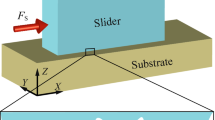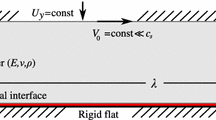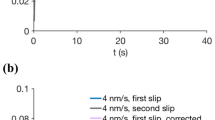Abstract
Macroscopic sliding between two solids is triggered by the propagation of a micro-slip front along the frictional interface. In certain conditions, sliding is preceded by the propagation of aborted fronts, spanning only part of the contact interface. The selection of the characteristic size spanned by those so-called precursors remains poorly understood. Here, we introduce a 1D toy model of precursors between a slider and a track in which the fronts are quasi-static self-healing slip pulses. When the slider’s thickness is large compared to the elastic correlation length and when the interfacial stiffness is small compared with the bulk stiffness, we provide an analytical solution for the length of the first precursor, \(\varLambda\), and the shear stress field associated with it. These quantities are given as a function of the bulk material parameters, the frictional properties of the interface and the macroscopic loading conditions. Analytical results are in quantitative agreement with the numerical solution of the model. In contrast with previous models, our model predicts that \(\varLambda\) does not depend on the frictional breaking threshold of the interface. Our results should be relevant to the various systems in which self-healing slip pulses have been observed.



Similar content being viewed by others
References
Persson, B.N.J.: Sliding Friction: Physical Principles and Applications. Springer, Berlin (1998)
Braun, O.M., Naumovets, A.G.: Nanotribology: Microscopic mechanisms of friction. Surf. Sci. Rep. 60, 79 (2006)
Chateauminois, A., Fretigny, C., Olanier, L.: Friction and shear fracture of an adhesive contact under torsion. Phys. Rev. E 81, 026106 (2010)
Prevost, A., Scheibert, J., Debrégeas, G.: Probing the micromechanics of a multi-contact interface at the onset of frictional sliding. Eur. Phys. J. E 36, 17 (2013)
Rubinstein, S.M., Cohen, G., Fineberg, J.: Detachment fronts and the onset of dynamic friction. Nature 430, 1005 (2004)
Rubinstein, S.M., Cohen, G., Fineberg, J.: Dynamics of precursors to frictional sliding. Phys. Rev. Lett. 98, 226103 (2007)
Maegawa, S., Suzuki, A., Nakano, K.: Precursors of global slip in a longitudinal line contact under non-uniform normal loading. Tribol. Lett. 38, 313 (2010)
Romero, V., Wandersman, E., Debrégeas, G., Prevost, A.: Probing locally the onset of slippage at a model multicontact interface. Phys. Rev. Lett. 112, 094301 (2014)
Trømborg, J.K., Sveinsson, H.A., Scheibert, J., Thøgersen, K., Amundsen, D.S., Malthe-Sørenssen, A.: Slow slip and the transition from fast to slow fronts in the rupture of frictional interfaces. Proc. Natl. Acad. Sci. USA 111, 8764–8769 (2014)
Braun, O.M., Barel, I., Urbakh, M.: Dynamics of transition from static to kinetic friction. Phys. Rev. Lett. 103, 194301 (2009)
Scheibert, J., Dysthe, D.K.: Role of friction-induced torque in stick-slip motion. EPL 92, 54001 (2010)
Amundsen, D.S., Scheibert, J., Thøgersen K., Trømborg J., Malthe-Sørenssen A.: 1D Model of precursors to frictional stick-slip motion allowing for robust comparison with experiments. Tribol. Lett. 45, 357 (2012)
Trømborg, J., Scheibert, J., Amundsen, D.S., Thøgersen, K., Malthe-Sørenssen, A.: Transition from static to kinetic friction: Insights from a 2D model. Phys. Rev. Lett. 107, 074301 (2011)
Braun, O.M., Peyrard, M., Stryzheus, D.V., Tosatti, E.: Collective effects at frictional interfaces. Tribol. Lett. 48, 11 (2012)
Braun, O.M., Peyrard, M.: Crack in the frictional interface as a solitary wave. Phys. Rev. E 85, 026111 (2012)
Lykotrafitis, G., Rosakis, A.J., Ravichandran, G.: Self-healing pulse-like shear ruptures in the laboratory. Science 313, 1765 (2006)
Ronsin, O., Baumberger, T., Hui, C.Y.: Nucleation and propagation of quasi-static interfacial slip pulses. J. Adhes 87, 504 (2011)
Caroli, C., Nozieres, P.: Hysteresis and elastic interactions of microasperities in dry friction. Eur. Phys. J. B 4, 233 (1998)
Brörmann, K., Barel, I., Urbakh, M., Bennewitz, R.: Friction on a microstructured elastomer surface. Tribol. Lett. 50, 3 (2013)
Thøgersen, K., Trømborg, J.K., Sveinsson, H.A., Malthe-Sørenssen, A., Scheibert, J.: History-dependent friction and slow slip from time-dependent microscopic junction laws studied in a statistical framework. Phys. Rev. E 89, 052401 (2014)
Baumberger, T., Caroli, C., Ronsin, O.: Self-healing slip pulses and the friction of gelatin gels. Eur. Phys. J. E 11, 85 (2003)
Braun, O.M., Peyrard, M.: Modeling friction on a mesoscale: Master equation for the earthquakelike model. Phys. Rev. Lett. 100, 125501 (2008)
Braun, O.M., Peyrard, M.: Master equation approach to friction at the mesoscale. Phys. Rev. E 82, 036117 (2010)
Braun, O.M., Peyrard, M.: Role of aging in a minimal model of earthquakes. Phys. Rev. E 87, 032808 (2013)
Acknowledgments
We wish to express our gratitude to M. Peyrard for numerous useful discussions. We thank J. K. Trømborg for a careful reading of the manuscript. This work was supported by a Dnipro Hubert Curien Partnership (Grant No. 28225UH) and by the People Programme (Marie Curie Actions) of the European Union’s 7th Framework Programme (FP7/2007–2013) under Research Executive Agency Grant Agreement 303871. O.B. acknowledges a partial support from the NASU “RESURS” program.
Author information
Authors and Affiliations
Corresponding author
Appendix: Analytical derivation of Eq. (25)
Appendix: Analytical derivation of Eq. (25)
Let us introduce two dimensionless parameters
so that \(K_{\rm L} = K/h\), \(K_{\rm T} = Kh/2(1+\sigma )\), \(\beta = 1/(1+b)\), \(1-\beta = b/(1+b)\), \((\lambda _{\rm c} \kappa _{\rm T})^2 = hq/b\), \((\lambda _{\rm c} \kappa )^2 = q \, (1+b)/b\),
where \(b = 2(1+\sigma )q/h\), and consider the typical system with \(h, q \ll 1\). In this case \(\varepsilon \ll 1\), so that \(\kappa _1^2 \approx \kappa ^2 (1+\beta \varepsilon )\) and \(\kappa _2^2 \approx \kappa ^2 \varepsilon \, (1-\beta ) = q \varepsilon /\lambda _{\rm c}^2\), or
In accordance with the numerics (see Fig. 2a), let us assume that in the case of \(h, q \ll 1\) the displacement field in the US is given by
and does not change during front propagation. Before nucleation of the first precursor, the solution of Eq. (7) is
The right-hand-side boundary condition, \(u(x) \rightarrow 0\) at \(x \rightarrow \infty\), gives us
while the left-hand-side boundary condition (Eq. (10)) leads to the equation
Thus, before nucleation of the first precursor, the IL displacement field is
Equation (33) allows us to couple the parameters \(U \equiv u_{\rm t} (0)\) and \(u_{\rm c} \equiv u(0)\):
where
When the displacement of the IL trailing edge reaches the threshold value \(u_{\rm s}\) at some \(U=U_0 = u_{\rm s} ( 1+ \kappa _2 /\kappa ) / (\beta \varPsi _1)\), the front starts to propagate. In this case the solution of Eq. (7), ahead of the propagating front, \(x>s\), where \(u_{\rm b} (x) =0\) so that \(w(x) = \beta u_{\rm t} (x) = \beta U_0 e^{-\kappa _2 x}\), is given by
The right-hand-side boundary condition gives us the coefficient \(A_4 (s)\),
so that Eq. (36) takes the form
Behind the propagating front, \(x<s\), where \(w(x) = \beta \, u_{\rm t} (x) + (1-\beta ) \, u_{\rm b} (x)\) and \(u_{\rm b} (x) = \widetilde{u}(x+0;x) = A_3 (x) + A_4 (x)\), the solution of Eq. (7) is given by
where
so that \({\mathcal {F}} (0) =0\) and \({\mathcal {F}}' (0) =0\).
The coefficients \(A_{\dots } (s)\) in these equations are determined by the boundary and continuity conditions. The left-hand-side boundary condition (Eq. (10)) couples the coefficients \(A_1 (s)\) and \(A_2 (s)\). Using \(u_{\rm b} (0)=u_{\rm s}\), \(\widetilde{u}(0;s) = A_2 (s)\) and \(\widetilde{u}'(0;s) = \kappa A_1 (s)\), we obtain
The continuity conditions (Eqs. (23) and (24)) lead to two equations
and
where
Taking the difference and sum of Eqs. (44) and (45), we obtain two new equations:
Using Eq. (43), Eqs. (46) and (47) may be rewritten as
Combining these equations, we finally come to the integral equation for the coefficient \(A_3 (s)\):
where
so that
From Eq. (52) we find that
Differentiating Eq. (52), we obtain a differential equation for \(A_3 (s)\):
From Eq. (56) we obtain that at short distances, \(s \ll \kappa ^{-1}\), \(A_3 (s) \approx A_3 (0) (1+ \gamma _3 s)\), where
From Eqs. (37) and (56) it follows that \(\widetilde{u} (s+0;s) = A_3 (s) + A_4 (s) \approx A_0 \, (1+\gamma s)\) at short distances, \(s \ll \kappa ^{-1}\), where
and
while for long distances, \(s \gg \kappa ^{-1}\), \(\widetilde{u} (s+0;s)\) decays exponentially,
The function \(\widetilde{u} (s+0;s)\) may be approximated as
where
and comparing Eqs. (59) and (61), we obtain a nonlinear equation, which defines the value \(\kappa _3\):
Then, the IL stress ahead of the front is \(\sigma _{\rm c} (s) = k \, \widetilde{u} (s+0;s) /\lambda _{\rm c}^2\), and the equation \(\sigma _{\rm c} (\varLambda ) = \sigma _{\rm s}\) defines the characteristic length \(\varLambda\):
where \(y\) is determined by the solution of the equation \({\mathcal {B}} y = (y+C)^{\alpha }\) with \({\mathcal {B}} = (1+C)^{\alpha } k A_0 /(\sigma _{\rm s} \lambda _{\rm c}^2)\).
Using Eq. (60), \(\varLambda\) may approximately be presented as
Equation (65) corresponds to the analytical solution for \(\varLambda\), whereas Eq. (66) corresponds to the approximated analytical solution provided as Eq. (25) in the main text.
Rights and permissions
About this article
Cite this article
Braun, O.M., Scheibert, J. Propagation Length of Self-healing Slip Pulses at the Onset of Sliding: A Toy Model. Tribol Lett 56, 553–562 (2014). https://doi.org/10.1007/s11249-014-0432-y
Received:
Accepted:
Published:
Issue Date:
DOI: https://doi.org/10.1007/s11249-014-0432-y




